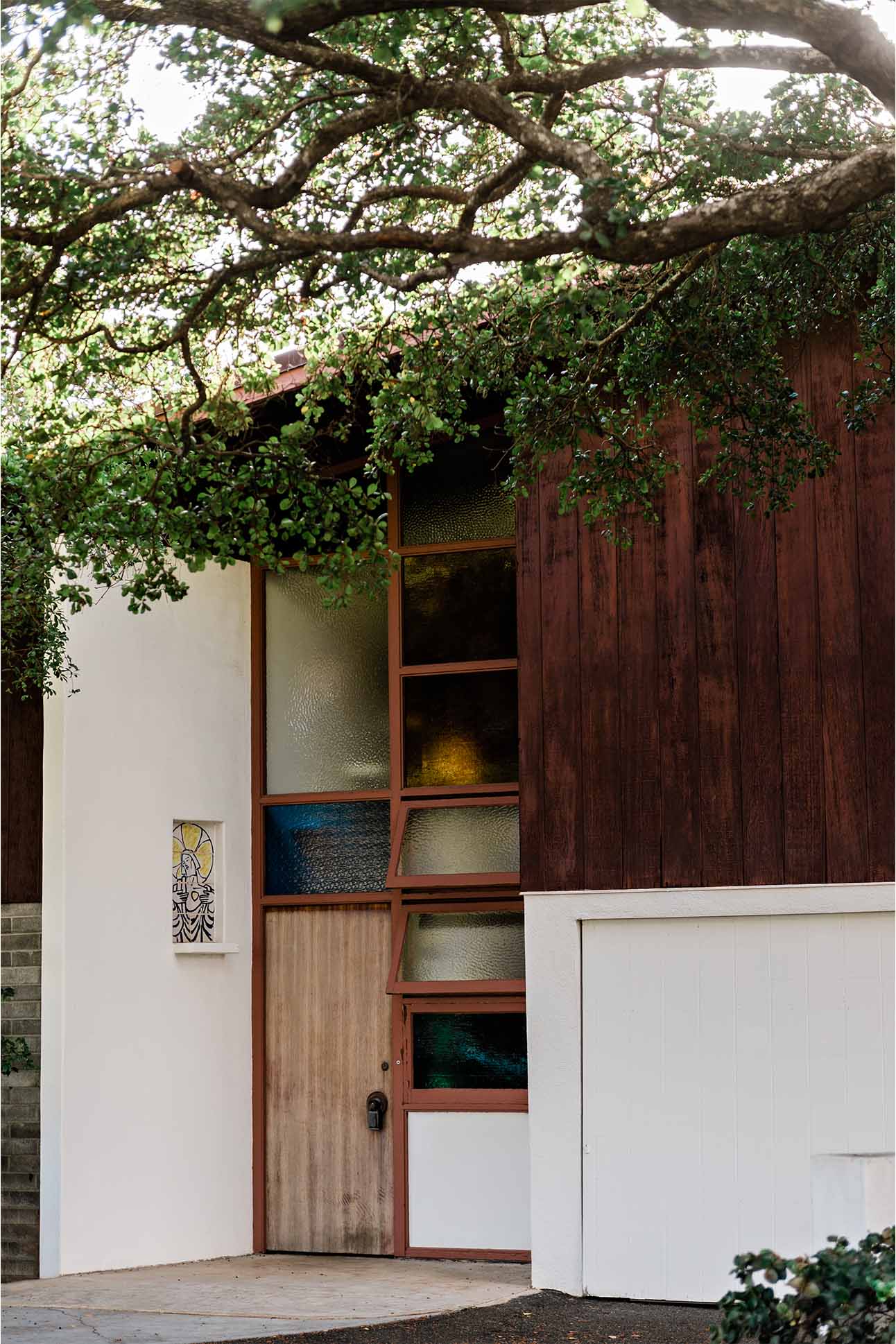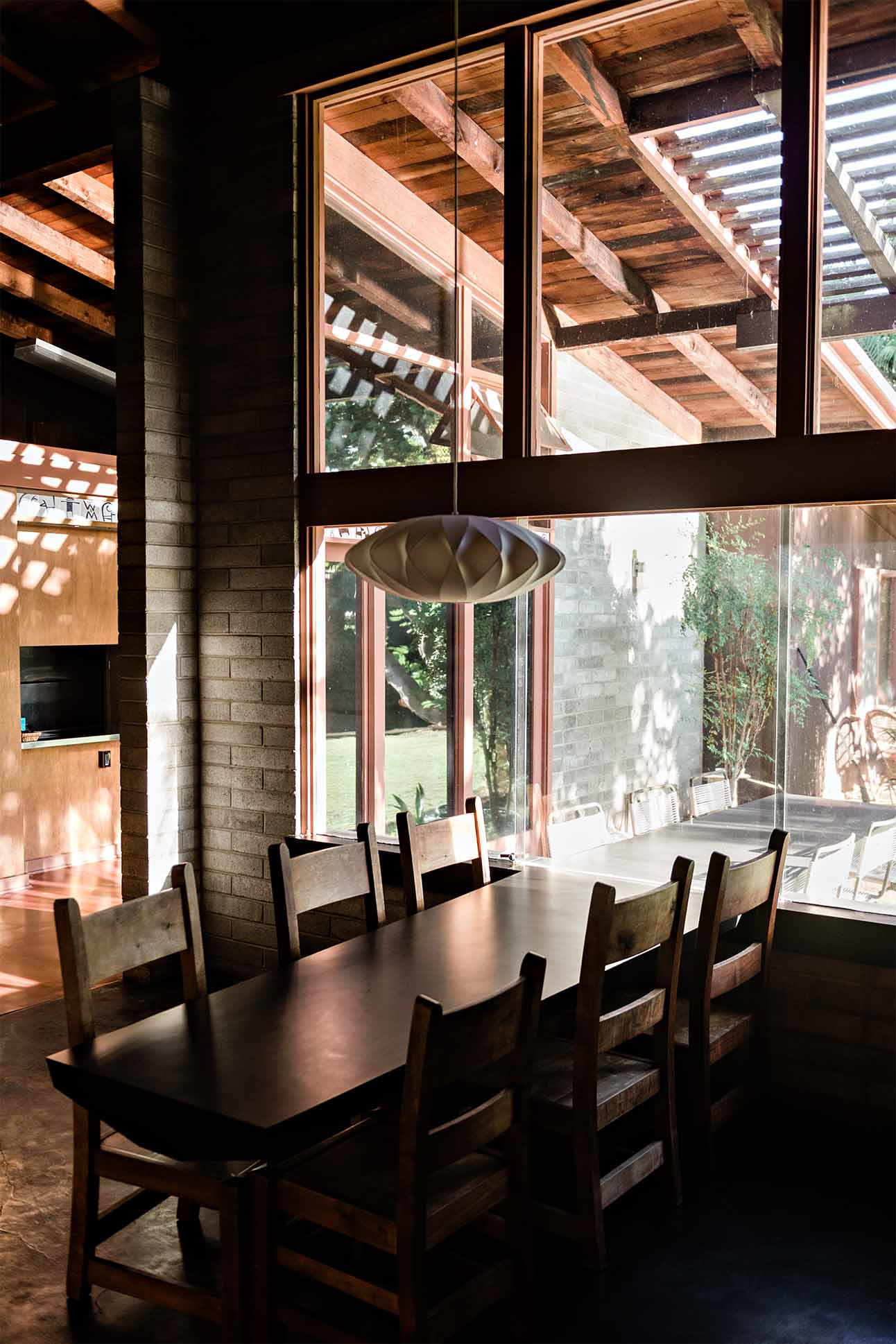Text by Eunica Escalante
Images by John Hook and Chris Rohrer
Remnants of the artist Jean Charlot still haunt the home. Past a series of cantilevered steps within what was once his studio are pinprick indentations along a curved cork wall, which Charlot made when he pinned up drafts of his famed murals. Ambling through the historic property, I stumble upon tiles of handpainted petroglyphs inlaid in the floors, walls, and beams like Easter eggs of artwork hidden throughout the structure.
Then there is the home’s pièce de résistance: Above a set of sliding glass doors that lead to the lānai is a fresco spanning the length of the living room. Native flora and tropical plants painted in the Aubusson style, a burst of thick foliage in verdant shades of green, fill the scene. It was completed by Charlot with the assistance of renowned Hawai‘i artist Juliette May Fraser, making it the first artwork to decorate the home—and the last. In the years since the home’s vacancy, when most of the art and books and personal memorabilia have been emptied out, this is among the final to remain.
From its completion in 1958 to Charlot’s death in 1979, this historic property in the quiet O‘ahu suburb of Kāhala was where the celebrated artist lived, played, and worked. Today, it is owned by the University of Hawai’i and preserved in partnership with the Historic Hawai‘i Foundation. Charlot first conceptualized the property in 1957, when a commission from the University of Hawai‘i at Mānoa for a fresco turned into a full-time teaching position in the university’s art department. He contracted noted Hawai‘i architect George J. “Pete” Wimberly to design it, but blueprints Charlot drafted in his sketchbook also show how involved he was in the design process.


There is a story that Bronwen Solyom, the former curator of UH Mānoa’s Jean Charlot collection, likes to tell. To design the color scheme of the stained-glass façade that would surround the entryway, Charlot drew a template. As if an instructor handing out homework, he disseminated it to friends and family to color in. In the end, Solyom says, Charlot settled on his own color scheme of cerulean, jade, and amber. Yet the idea was very much of Charlot’s nature as a nurturer of creativity, especially in others.
The split-level ranch style home is a blend of Charlot’s French and Mexican backgrounds. Its vertical emphasis evokes the French rural architecture of his childhood. The brick floors and spacious back courtyard are reminiscent of the Mexican homes that Charlot, who was of Aztec descent, inhabited in his early adulthood as an artist working among the likes of Diego Rivera and Fernando Leal.
Yet the home is still uniquely of the Hawaiian Islands, reflecting the sense of place that Charlot often emphasized in his work. There is the wrap-around lānai, a quintessential Hawai‘i design. Natural materials, many of them native, texturize the home, such as the slab wall separating the dining and living rooms which is made entirely of hāpu‘u, the Hawaiian tree fern. It seems like an ordinary wall until a sliver of sunlight streams in, illuminating the countless sprigs crisscrossing its surface. “I don’t think I’ve seen this feature in any other home,” says Daniel Friedman, former dean of the UH Mānoa School of Architecture. “It truly is unique.”



Contrary to his earlier works, which centered human subjects, Charlot’s Hawai‘i phase was stirred by the verdant landscape that surrounded him and inspired by the way Native Hawaiian art symbolically merged man and nature. “Mexico focused on human beings, who carried the main message of an artwork; Hawai‘i focused on an all-encompassing nature,” his son, John Charlot, wrote in an essay examining his father’s relationship to Hawaiian culture. “Rather than the environment and the human community being separate, in Charlot’s mural they form a coherent whole, all bathed in the beautiful local light.”
This coherence of nature and man is evident throughout the home’s design, which blurs the interior and exterior. Floor-to-ceiling glass doors create the illusion of a home with no walls, while natural materials like hāpu‘u and ‘ōhi‘a wood bring the outdoors in. The dining table is the paragon of this philosophy. Designed by Charlot himself, the table branches out from the exterior wall, one half in and the other out, the delineation made by sliding glass windows that meet on top of the table’s middle. During the many soirées held by the Charlots, which were frequented by many in Hawai‘i’s intellectual circles (evidenced by the home’s guestbook), the windows were slid open, the congregation transcending the home’s physical barriers. The artist’s perspective and innovation now serve as inspiration for UH students.
Walking through the house, feeling my feet atop the hardwood floors where Charlot walked, it is hard to shake the feeling that the artist is still there. After more than two decades living in the home, this was where he spent the last of his days in March 1979. Six months earlier, he completed his last mural, for Maryknoll Elementary School, part of the many public art works he did for the state.
“Charlot pops into people’s lives in so many different ways—be it through a mural at their old school or a print they’ve discovered,” Solyom says. “It’s inspiring to know he’s touched so many people.”




